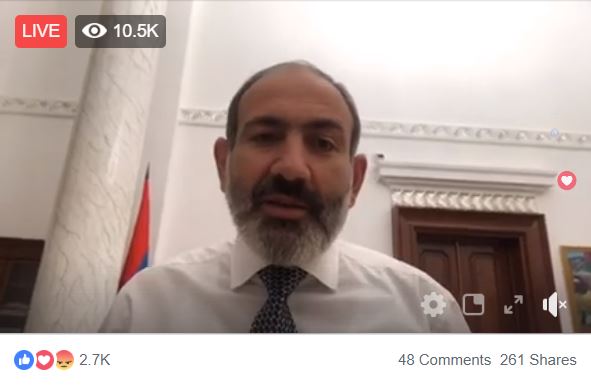 YEREVAN—Challenging this snap parliamentary election season’s run-of-the-mill feel, Facebook Live has suddenly emerged as a major campaign tool among the traditional hallmarks of election posters, televised debates, flyers, and door-to-door campaigns. The service, which Facebook launched in 2015, became an early hit among Armenia’s activist network, which used it to share footage of protests or electoral violations in real time.
YEREVAN—Challenging this snap parliamentary election season’s run-of-the-mill feel, Facebook Live has suddenly emerged as a major campaign tool among the traditional hallmarks of election posters, televised debates, flyers, and door-to-door campaigns. The service, which Facebook launched in 2015, became an early hit among Armenia’s activist network, which used it to share footage of protests or electoral violations in real time.
Facebook Live definitively altered the Armenian political landscape when Nikol Pashinyan, then leader of the Yelq Alliance opposition group, began live broadcasts to coordinate the protests which eventually culminated in the Velvet Revolution. He has been broadcasting live since July 2016.
Pashinyan’s continued use of the platform has helped him maintain the image of an ‘approachable’ politician, in stark contrast with his predecessor, Serzh Sargsyan, who shunned media appearances in general. His daily broadcasts attracted tens of thousands of live viewers, who would often send him messages of support or ask him about issues.
Other Civil Contract politicians have also adopted this style. Andrey Ghukasyan, the new Governor of Lori region, and chess master Tigran Petrosyan have both gathered quite a following on their feeds. Victor Yenkibaryan, a candidate with the My Step alliance told the Weekly, “The platform’s spontaneous nature gives voters a ‘face-to-face” relationship with their candidate, making the candidate feel more relatable. The electorate can peer into the everyday lives of their representatives”. He insists that it works, pointing to the ever-increasing engagement metrics since he’s started streaming.
Potential voters seem to be taking interest. Sveta Jaghatspanian, a 28 year-old software engineer from Vanadzor says she got to know many of the My Step candidates by following them on the live streaming platform. Facebook’s live map shows little dots across the country, every single one of them representing coverage of an election rally or a candidate who is live-streaming.
Though social media has been playing an increased role in Armenian elections over the last few election cycles, with parties pouring money into Facebook advertising campaigns and designing sleek video ads, Facebook Live is a relatively new phenomenon.
According to Dr. Katy Pearce, a professor at the University of Washington researching social and political uses of digital technologies in the South Caucasus, as of December, there are some 1.4 million Facebook subscribers in Armenia. That’s almost half the population. Among the country’s 15 to 24 year olds, the number jumps to 87-percent. This level of penetration allows candidates to reach large audiences easily. According to her, some 200,000 new users have subscribed to the social media platform since May, but she cautions against attributing this growth entirely to the Velvet Revolution. “About 100,000 Armenians join Facebook each quarter or so anyway,” she says.
Facebook Live’s value as a medium hasn’t been lost of the Republican Party (RPA) either. In an effort to present a younger and fresher face, a new generation of RPA leaders has taken to the platform to appeal to voters. Arpine Hovhannisyan, a former Minister of Justice under the Republicans, and Eduard Sharmazanov, another senior RPA official have both made numerous broadcasts lamenting what they called “abuses of power by the new administration.”
The parliamentary election is scheduled for Sunday, December 9.


Thank you for this informative article.
I am wondering why this article is NOT listed under the “Notes from the Pink City” column?
Hello, Antoine. Thank you for reading. In addition to being our “Notes from the Pink City” columnist, Raffi Elliott is also writing news reports from Armenia.